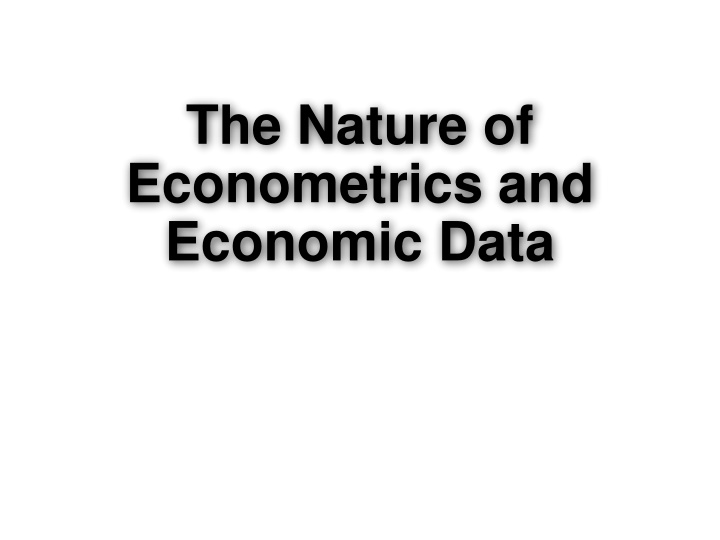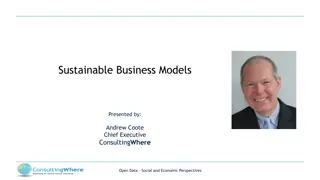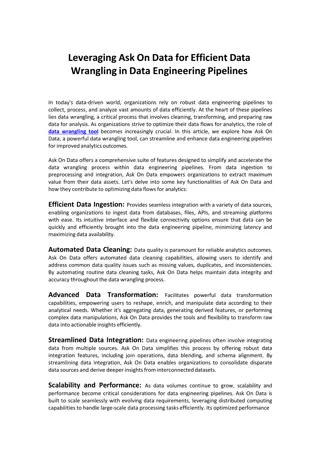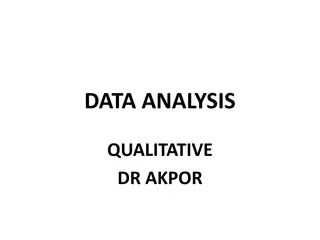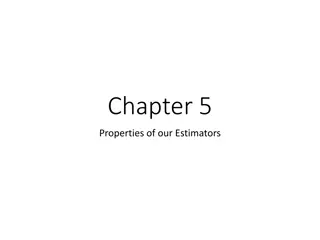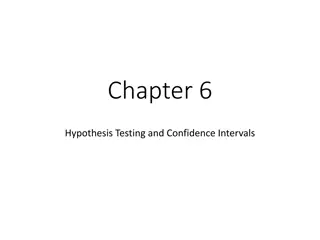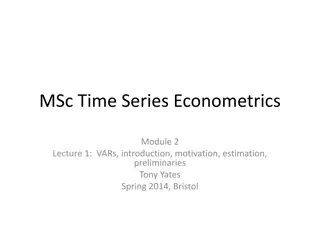The Nature of Econometrics and Economic Data Analysis
Econometrics is the application of statistical methods to analyze economic data. It involves estimating relationships between economic variables, testing theories and hypotheses, forecasting economic variables, and evaluating government and business policies. Econometric analysis includes steps like defining economic models, establishing relationships between variables, and specifying functional forms. Examples include models of criminal activity and job training on worker productivity.
Download Presentation

Please find below an Image/Link to download the presentation.
The content on the website is provided AS IS for your information and personal use only. It may not be sold, licensed, or shared on other websites without obtaining consent from the author.If you encounter any issues during the download, it is possible that the publisher has removed the file from their server.
You are allowed to download the files provided on this website for personal or commercial use, subject to the condition that they are used lawfully. All files are the property of their respective owners.
The content on the website is provided AS IS for your information and personal use only. It may not be sold, licensed, or shared on other websites without obtaining consent from the author.
E N D
Presentation Transcript
The Nature of Econometrics and Economic Data
The Nature of Econometrics and Economic Data What is econometrics? use of statistical methods to analyze economic data Econometricians typically analyze nonexperimental data Experimental data has a treatment and control group that are randomly assigned. Typical goals of econometric analysis Estimating relationships between economic variables Testing economic theories and hypotheses Forecasting economic variables Evaluating and implementing government and business policy Nature of Econometrics and Economic Data 2
The Nature of Econometrics and Economic Data Steps in econometric analysis 1) Economic model Sometimes skipped because the economics are simple 2) Econometric model Economic models May be micro- or macro-models (intermediate theory courses; field courses...) Often use optimizing behaviour, equilibrium modeling, Establish relationships between economic variables Examples: demand equations, pricing equations, Nature of Econometrics and Economic Data 3
The Nature of Econometrics and Economic Data Economic model of crime (Becker (1968)) Derives equation for criminal activity based on utility maximization Hours spent in criminal activities Age Wage of cri- minal activities Expected sentence Probability of conviction if caught Wage for legal employment Other income Probability of getting caught Functional form of relationship not specified Equation could have been postulated without economic modeling Nature of Econometrics and Economic Data 4
The Nature of Econometrics and Economic Data Model of job training and worker productivity What is effect of additional training on worker productivity? Formal economic theory not really needed to derive equation: Hourly wage Years of formal education Weeks spent in job training Years of work- force experience Other factors may be relevant, but these may be the most important What happens if other relevant variables are not controlled for? Nature of Econometrics and Economic Data 5
The Nature of Econometrics and Economic Data Econometric model of criminal activity The functional form has to be specified Variables may have to be approximated by other quantities Wage for legal employment Other income Frequency of prior arrests Measure of criminal activity Unobserved deter- minants of criminal activity e.g. moral character, wage in criminal activity, family background Frequency of conviction Average sentence length after conviction Age Nature of Econometrics and Economic Data 6
The Nature of Econometrics and Economic Data Econometric model of job training and worker productivity Unobserved deter- minants of the wage e.g. innate ability, quality of education, family background Years of formal education Years of work- force experience Weeks spent in job training Hourly wage Much of econometrics deals with the specification of the error Econometric models may be used for hypothesis testing For example, the parameter ?3represents effect of training on wage How large is this effect? Is it different from zero? Models may allow for non-linear effects (e.g. Quadratic) or interaction effects (e.g. educ*exper) Nature of Econometrics and Economic Data 7
The Nature of Econometrics and Economic Data Econometric analysis requires data Different kinds of economic data sets Cross-sectional data Time series data Pooled cross sections Panel/Longitudinal data Econometric methods depend on the nature of the data used Use of inappropriate methods may lead to biased and misleading results Nature of Econometrics and Economic Data 8
The Nature of Econometrics and Economic Data Cross-sectional data sets Sample of individuals, households, firms, cities, states, countries, or other units of interest at a given point of time/in a given period Cross-sectional observations are more or less independent For example, pure random sampling from a population Sometimes pure random sampling is violated, e.g. units refuse to respond in surveys, or if sampling is characterized by clustering Cross-sectional data typically encountered in applied microeconomics Nature of Econometrics and Economic Data 9
The Nature of Econometrics and Economic Data Cross-sectional data set on wages and other characteristics Indicator (dummy) variables (1 = yes, 0 = no) Hourly wage Observation number Years of education Years of experience Nature of Econometrics and Economic Data 10
The Nature of Econometrics and Economic Data Time series data Observations of a variable or several variables over time e.g. stock prices, money supply, consumer price index, gross domestic product, annual homicide rates, automobile sales, Ordering of observations conveys important information Data frequency: daily, weekly, monthly, quarterly, annually, Typical features of time series: trends and seasonality Typical applications: applied macroeconomics and finance Nature of Econometrics and Economic Data 11
The Nature of Econometrics and Economic Data Time series data on minimum wages and related variables Average minimum wage for the given year Average coverage rate Unemployment rate Gross national product Nature of Econometrics and Economic Data 12
The Nature of Econometrics and Economic Data Pooled cross sections Two or more cross sections are combined in one data set Cross sections are drawn independently of each other Pooled cross sections often used to evaluate policy changes Example: Evaluate effect of change in property taxes on house prices Random sample of house prices for the year 1993 A new random sample of house prices for the year 1995 Compare before/after (1993: before reform, 1995: after reform) Nature of Econometrics and Economic Data 13
The Nature of Econometrics and Economic Data Pooled cross sections on housing prices Property tax Size of house in square feet Number of bedrooms Number of bathrooms Before reform After reform Nature of Econometrics and Economic Data 14
The Nature of Econometrics and Economic Data Panel or longitudinal data The same cross-sectional units are followed over time Panel data have a cross-sectional and a time series dimension Panel data can be used to account for time-invariant unobservables Panel data can be used to model lagged responses Example City crime statistics; each city is observed in two years Time-invariant unobserved city characteristics may be modeled Effect of police on crime rates may exhibit time lag Nature of Econometrics and Economic Data 15
The Nature of Econometrics and Economic Data Two-year panel data on city crime statistics Each city has two time series observations Number of police in 1986 Number of police in 1990 Nature of Econometrics and Economic Data 16
The Nature of Econometrics and Economic Data Causality and the notion of ceteris paribus Definition of causal effect of on : How does y change if x is changed but all other relevant factors are held constant Most economic questions are ceteris paribus questions It is useful to describe how an experiment would have to be designed to infer the causal effect in question It is important to note that correlation does not necessarily imply causation. Nature of Econometrics and Economic Data 17
The Nature of Econometrics and Economic Data Causal effect of fertilizer on crop yield By how much will the production of soybeans increase if one increases the amount of fertilizer applied to the ground Implicit assumption: all other factors that influence crop yield such as quality of land, rainfall, presence of parasites etc. are held fixed Experiment: Choose several one-acre plots of land; randomly assign different amounts of fertilizer to the different plots; compare yields Experiment works because amount of fertilizer applied is unrelated to other factors influencing crop yields Non-experimental Random sample of farm plots with information on fertilizer and yield. Is relationship between fertilizer and yield causal? Nature of Econometrics and Economic Data 18
The Nature of Econometrics and Economic Data Measuring the return to education If a person is chosen from the population and given another year of education, by how much will his or her wage increase? Implicit assumption: all other factors that influence wages such as experience, family background, intelligence etc. are held fixed Experiment: Choose a group of people; randomly assign different amounts of education to them (probably infeasable); compare wage outcomes Problem without random assignment: amount of education is related to other factors that influence wages (e.g. Intelligence, motivation, family background) Nature of Econometrics and Economic Data 19
The Nature of Econometrics and Economic Data Effect of law enforcement on city crime level If a city is randomly chosen and given ten additional police officers, by how much would its crime rate fall? Alternatively: If two cities are the same in all respects, except that city A has ten more police officers than city B, by how much would the two cities crime rates differ? Experiment: Randomly assign number of police officers to a large number of cities In reality, number of police officers will be determined by crime rate (simultaneous determination of crime and number of police) Nature of Econometrics and Economic Data 20
The Nature of Econometrics and Economic Data Effect of the minimum wage on employment By how much (if at all) will employment decrease if the minimum wage is increased by a certain amount (holding other things fixed)? Experiment: Government randomly chooses minimum wage each year and observes employment outcomes Experiment will work because level of minimum wage is unrelated to other factors determining employment In reality, the level of the minimum wage depends on political and economic factors that also influence unemployment Nature of Econometrics and Economic Data 21
